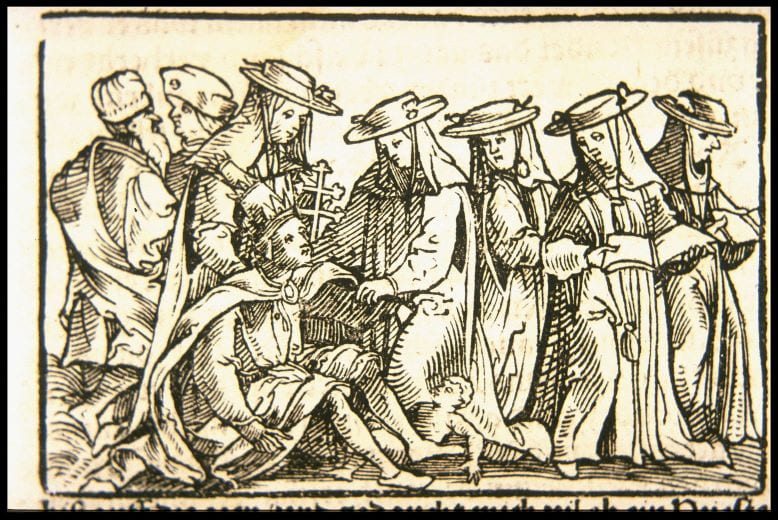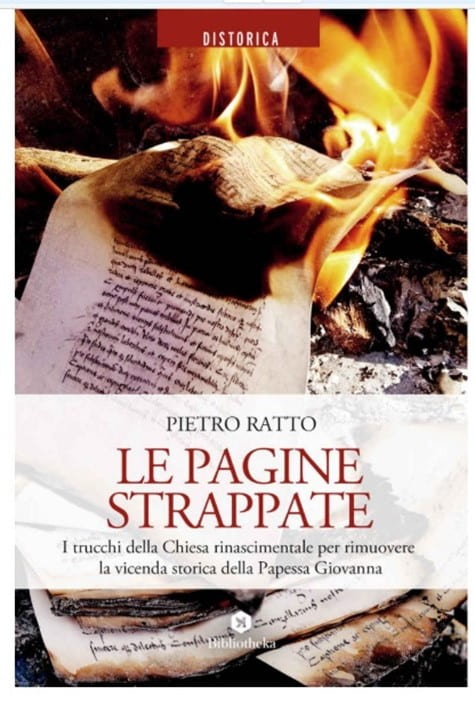By Stefan Bauer
The Roman publisher Bibliotheka has recently reissued Le pagine strappate (Torn-Out Pages), a book that originally came out in 2014. In it, the Italian journalist and history teacher Pietro Ratto argues that the Catholic Church has destroyed embarrassing sources about its history. Ratto condemns the alleged “dirty tricks” that the Renaissance Church used to remove historical evidence about Pope Joan—a woman who many believe ascended the papal throne in the ninth century, duping the Roman establishment by dressing as a man, and who then tragically died in childbirth during a procession. It’s such a captivating story that, in a sense, we all want Joan to have existed.
Yet how much truth is there to the claim that the Catholic Church altered its history? Were embarrassing facts—such as the existence of Joan—hidden away? To answer such questions, it’s useful to look back at how history was written, interpreted, and challenged before and after the Reformation.
Before the Protestant Reformation began in 1517, the most innovative and critical historians were Renaissance humanists. Although humanists were engaged, to a large degree, in the study and imitation of ancient Latin, this also meant that they were necessarily aware of the development of the Latin language from antiquity through the Middle Ages and up to their own day. This taught them a sense of the historical distance that separated their times from antiquity. Classical literature was understood as a historical phenomenon. There was a spirit of criticism arising from this combination of both respecting and challenging antiquity. Regardless of whether humanists were backward-looking progressives or forward-looking conservatives, their engagement with the classics led them to critique the language, morals, and customs of their own age. Several humanists applied their philological skills to the text of the Bible and to church history.
Church history, however, was by no means a natural subject matter for humanists. The Vatican’s head librarian Bartolomeo Platina (ca. 1421–81), for example, faced the uneasy task of adapting the badly written medieval biographies of the popes to humanist expectations. Platina gave several justifications for his task, all typically humanist. First, unsurprisingly, history was didactic. Remembering the deeds of those who had built the ‘Christian republic’ would serve as an inspiration for posterity. Second, Platina put forward a stylistic argument. He lamented that many late antique and medieval authors did “not attempt any ornate speech, artistic composition or elegance.” So, in writing church history, the principal aim of fifteenth-century humanists was to restore the classical Latin style, and Platina’s book clearly expressed this belief.
As for source criticism, Platina called into question some legends deriving from late antiquity and the Middle Ages. For instance, with regard to the baptism of Emperor Constantine the Great, he stated, “I do not believe at all that, as is widely held, Constantine contracted leprosy and was cured of it by baptism.” Medieval tales about Pope Silvester II (r. 999–1003) claimed that the bones in his tombs rattled to foretell the death of other popes. Platina was amused by this story and commented sarcastically: “Let those popes whom it concerns judge whether it is true or not.” Commenting on the legend of Pope Joan, he took a cautious approach, stating that it was recorded only by unreliable and obscure authors.
After the Reformation, both Catholic and Protestant humanists faced the demands of their competing churches. The prevailing models of church history did not suit the Protestants’ view of a degenerate medieval Church, which not only precipitated their calls for reform but also required Protestant historians to re-invent the discipline. Some Reformers emphasized human fallibility and the deterioration of what had been, initially, good intentions for the religious life. Others adopted a more strident stance. Most notably, the authors of a Protestant church history known as the Magdeburg Centuries (1559–74) maintained that the false institution of the papacy, compounded by erroneous teachings and the watering down of the Gospel, had inevitably led to degradation. In response, Catholics deployed historical arguments to demonstrate the legitimacy of papal power, as a means of bolstering the primacy of the pope against the challenge mounted by Protestants.
Catholics, therefore, often clung to invented traditions, while Protestants were keen to dismantle them. In the case of Pope Joan, however, it was the other way round. Catholic church historians of the sixteenth century such as Onofrio Panvinio (1530–68) learned some of the tools of philology from their humanist predecessors. Panvinio, an Augustinian friar who received financial support from a wealthy cardinal, became one of the few full-time historians of his day, working on the history of both ancient Rome and the Church. He also edited and continued Platina’s Lives of the Popes. Among the best-known results of his research was his refutation, in 1562, of the story of Pope Joan. Panvinio employed a typical humanist argument: he pointed out that there were no contemporary or near contemporary sources that reported the story of the female pope, and consequently concluded that the legend of Joan was a later medieval invention. Panvinio was right: Joan—who is supposed to have lived in the ninth century—was never mentioned before the thirteenth century. The authors of the Protestant Magdeburg Centuries, who had a very different agenda, ignored humanist practice and brushed aside Panvinio’s argument about the lack of sources, maintaining instead that ninth-century ecclesiastical writers had “deliberately omitted Joan’s name and dates because of the disgrace and because she was a woman.”
In his book on “torn-out pages”, Pietro Ratto takes this view even further by claiming not merely that the earliest sources documenting Joan’s existence were destroyed by the Church, but also that Panvinio sought to conceal the fact that this had happened. It’s worth examining Ratto’s arguments more closely. Unable to explain exactly how the Church “erased” the traces of Joan from the ninth-century manuscripts, Ratto adopts a twofold strategy. He first tries to push back the date at which Joan appears in historical accounts, stating that the oldest references are from the eleventh century—not from the thirteenth century, as is the scholarly consensus today. Ratto’s aim in doing so is to narrow the gap in the source material by two hundred years; but he undermines his argument by conveniently ignoring the fact that the supposed eleventh-century references, such as those in Marianus Scotus’s Chronicle, were later interpolations in the manuscripts. Not even the journalist Peter Stanford—who in his The She-Pope (Heinemann, 1998) indulges in many other types of speculation—claims that any written references to Joan from before the thirteenth century have survived.
What is more interesting in Ratto’s book is his second strategy, by which he tries to show that, in Platina’s and Panvinio’s papal histories, dates and papal names were manipulated. Ratto rightly observes that the numbering of popes varied in the different posthumous editions of these histories: some of the editors counted Joan as Pope John VIII, while others did not assign her a number at all. This divergence, in practice, had ripple-on effects on the numbering of subsequent popes named John. According to Ratto, these variations are evidence of illicit tinkering with the sources by Panvinio and others. In reality, however, they were simply the result of the efforts of scholars to grapple with papal chronology. Up to the present day, there have been almost two dozen popes named John, beginning with John I in the sixth century and ending with John XXIII (1958–63). A number of these popes reigned in the eighth and ninth centuries, a period for which we have comparatively few contemporary sources. (The official, medieval series of lives of the popes, Liber pontificalis, broke off in 886, after which it was continued, not with proper biographies, but rather with short tables called catalogues that provided little information.) What’s more, some of the popes named John were antipopes—a fluid and contested category in papal history—contributing further to changes in the numbering. At any rate, none of the editorial interventions by Platina, Panvinio or their editors indicate that any ninth-century evidence about Joan was destroyed. Ratto’s smoking guns are imaginary.
Pope Joan is an example of the persistence of a myth, despite centuries of critical scholarship. This legend seems to provoke a particularly obstinate kind of resistance to critical argument, demonstrating how powerful the popular imagination, combined with the polemical uses of an attention-grabbing story, could be and, indeed, still is. Although the methods of inquiry that historians use today are grounded in humanist philology and rigour, some authors, like Ratto, forget, or perhaps disregard, the salutary lessons of humanist source criticism. Instead, they revive the medieval traditions of myth-making. More widely, like the legend of Joan, other forgeries in church history have also frequently been connected to historical processes involving both critical recognition and long-term denial—a theme which I hope to examine more fully elsewhere.
Dr. Stefan Bauer is Lecturer in Early Modern World History at King’s College London. He has written widely on church history, censorship, and religious polemic. His most recent book is The Invention of Papal History: Onofrio Panvinio between Renaissance and Catholic Reform (Oxford University Press, 2020).
Featured Image: Burgmair, [Pope Joan Giving Birth], ca. 1545. Courtesy of Cornell University Library.





1 Pingback